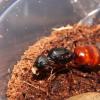1. Found in paradise California
2. Found June 24th
3. Pine forest
4.unknown
5.black gasture, red/orangish head and thorax and legs are orange
6. Number 5
7.no
8.unknown
9.unknown
10.pictures below





If better pictures are asked I can’t cause I live 1 hour away from that town and that’s the only time he has seen them before. These are screenshots from a video also. Thanks you!
Sent from my iPhone using Tapatalk
Edited by KadinB, August 16 2021 - 10:44 PM.

















